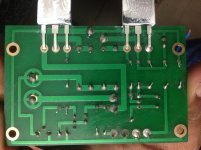@Zen Mod
Thank you for your help, here are the pictures. What measurements you are looking for, if you could brief me on it that would be great. I use 19v 3.42 Amp adapter. The bias is set at 10v DC
triple check value of resistors and their positioning
also - be sure that signal is actually reaching pcb and that here is no some sort of short underneath
make some measurements ( few of them to check are already on schematic) and post here
Thanks Zen, patience appreciated for an old man with limited electronic background. I believe I understand what you are saying and that Iq needs to be measured possible across a resistor as previous builds and voltage increase via pot may not be related to raising iq. I increased the voltage with the pot to 12V without noticing much if any difference with temp or sound. Still sounds fantastic with horns. I enjoy SET with plenty of 2nd harmonics in spells and this amp seems to sound very SET like.
if you already have 2k2 mod , then you're done with 19V supply
if you're going to stay there , back up output node voltage where Papa sez , to preserve best symmetry and symmetrical clipping
if you want more , acquire 24Vdc brick , rebias output node 5V up and it will be both hotter and ....... hotter

if you're going to stay there , back up output node voltage where Papa sez , to preserve best symmetry and symmetrical clipping
if you want more , acquire 24Vdc brick , rebias output node 5V up and it will be both hotter and ....... hotter

if you already have 2k2 mod , then you're done with 19V supply
if you're going to stay there , back up output node voltage where Papa sez , to preserve best symmetry and symmetrical clipping
if you want more , acquire 24Vdc brick , rebias output node 5V up and it will be both hotter and ....... hotter

Understand will do, thanks.
It's not lead free, after solder I just cleaned the pcb with thinner it gives the neat finish 
The output transistor is soldered in front and plated through hole. I will do it in back of pcb as well. The resistor values are correct and their placements. Would it be if any components are faulty?
The output transistor is soldered in front and plated through hole. I will do it in back of pcb as well. The resistor values are correct and their placements. Would it be if any components are faulty?
Pass DIY Addict
Joined 2000
Paid Member
I have two ACA builds, one makes a small thump at power off, the other doesn't. I've attributed this to the specific laptop power brick that each uses since they are different. Everything else is the same.
As for why kapalin's build doesn't work, check a few things. Make sure you have no cold solder joints. Make sure you didn't mix up Q3 and Q4 locations. Double check each pin on both mosfets with your DMM to make sure there is not something grounding them to the heatsink. Each should measure as an open loop. Also, check your screws/nuts where the PCB is mounted to the sink to make sure nothing is grounding or allowing a resistor tail to hit the sink.
The beauty of this circuit is its simplicity. It makes trouble shooting easy compared to the more complex designs because there are fewer things to check.
As for why kapalin's build doesn't work, check a few things. Make sure you have no cold solder joints. Make sure you didn't mix up Q3 and Q4 locations. Double check each pin on both mosfets with your DMM to make sure there is not something grounding them to the heatsink. Each should measure as an open loop. Also, check your screws/nuts where the PCB is mounted to the sink to make sure nothing is grounding or allowing a resistor tail to hit the sink.
The beauty of this circuit is its simplicity. It makes trouble shooting easy compared to the more complex designs because there are fewer things to check.
I've attributed this to the specific laptop power brick that each uses since they are different. Everything else is the same.
So are you actually using a 24 V laptop PS on the 5 W amp? I am planning on using one of my old 24 V/4.7 A laptop power supply on my ACA 1.5 5 W amp in order to boost it's output to 6 W but I am not sure if that will cause any problem.
Starting at steps 44 of the illustrated build guide, IIRC
Step 44 for balanced input mode, using an XLR input ( clearly the preferred option), and 46 for single ended with external resistively loaded jumper.
Note, I think Jim had mentioned the connection error in Step 48 photo - i.e. the jumper should be connected to left channel black speaker post - but it looks like the photo has not yet been revised?
Step 44 for balanced input mode, using an XLR input ( clearly the preferred option), and 46 for single ended with external resistively loaded jumper.
Note, I think Jim had mentioned the connection error in Step 48 photo - i.e. the jumper should be connected to left channel black speaker post - but it looks like the photo has not yet been revised?
- Home
- Amplifiers
- Pass Labs
- ACA illustrated build guide
